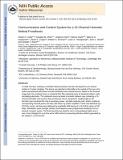| dc.contributor.author | Kelly, Shawn K. | |
| dc.contributor.author | Shire, Douglas B. | |
| dc.contributor.author | Chen, Jinghua | |
| dc.contributor.author | Gingerich, Marcus D. | |
| dc.contributor.author | Cogan, Stuart F. | |
| dc.contributor.author | Drohan, William A. | |
| dc.contributor.author | Theogarajan, Luke S. | |
| dc.contributor.author | Wyatt, John L. | |
| dc.contributor.author | Rizzo, Joseph F. | |
| dc.contributor.author | Doyle, Patrick S. | |
| dc.date.accessioned | 2015-10-16T12:59:16Z | |
| dc.date.available | 2015-10-16T12:59:16Z | |
| dc.date.issued | 2011-06 | |
| dc.date.submitted | 2011-02 | |
| dc.identifier.issn | 17468094 | |
| dc.identifier.uri | http://hdl.handle.net/1721.1/99352 | |
| dc.description.abstract | A small, hermetic, wirelessly-controlled retinal prosthesis has been developed for pre-clinical studies in Yucatan minipigs. The device was attached conformally to the outside of the eye in the socket and received both power and data wirelessly from external sources. Based on the received image data, the prosthesis drove a subretinal thin-film polyimide array of sputtered iridium oxide stimulating electrodes. The implanted device included a hermetic titanium case containing a 15-channel stimulator and receiver chip and discrete circuit components. Feedthroughs in the hermetic case connected the chip to secondary power- and data-receiving coils, which coupled to corresponding external power and data coils driven by power amplifiers. Power was delivered by a 125 kHz carrier, and data were delivered by amplitude shift keying of a 15.5 MHz carrier at 100 kbps. Stimulation pulse strength, duration and frequency were programmed wirelessly from an external computer system. The final assembly was tested in vitro in physiological saline and in vivo in two minipigs for up to five and a half months by measuring stimulus artifacts generated by the implant's current drivers. | en_US |
| dc.description.sponsorship | United States. Dept. of Veteran Affairs | en_US |
| dc.description.sponsorship | United states. Dept. of Veterans Affairs. Boston Healthcare System | en_US |
| dc.description.sponsorship | National Institutes of Health (U.S.) | en_US |
| dc.description.sponsorship | United States. Dept. of Defense | en_US |
| dc.description.sponsorship | Massachusetts Lions Foundation | en_US |
| dc.language.iso | en_US | |
| dc.publisher | Elsevier | en_US |
| dc.relation.isversionof | http://dx.doi.org/10.1016/j.bspc.2011.05.007 | en_US |
| dc.rights | Creative Commons Attribution-Noncommercial-NoDerivatives | en_US |
| dc.rights.uri | http://creativecommons.org/licenses/by-nc-nd/4.0/ | en_US |
| dc.source | PMC | en_US |
| dc.title | Communication and control system for a 15-channel hermetic retinal prosthesis | en_US |
| dc.type | Article | en_US |
| dc.identifier.citation | Kelly, Shawn K., Douglas B. Shire, Jinghua Chen, Patrick Doyle, Marcus D. Gingerich, Stuart F. Cogan, William A. Drohan, Luke S. Theogarajan, John L. Wyatt, and Joseph F. Rizzo. “Communication and Control System for a 15-Channel Hermetic Retinal Prosthesis.” Biomedical Signal Processing and Control 6, no. 4 (October 2011): 356–363. | en_US |
| dc.contributor.department | Massachusetts Institute of Technology. Department of Chemical Engineering | en_US |
| dc.contributor.department | Massachusetts Institute of Technology. Research Laboratory of Electronics | en_US |
| dc.contributor.mitauthor | Kelly, Shawn K. | en_US |
| dc.contributor.mitauthor | Doyle, Patrick S. | en_US |
| dc.contributor.mitauthor | Drohan, William A. | en_US |
| dc.contributor.mitauthor | Wyatt, John L. | en_US |
| dc.relation.journal | Biomedical Signal Processing and Control | en_US |
| dc.eprint.version | Author's final manuscript | en_US |
| dc.type.uri | http://purl.org/eprint/type/JournalArticle | en_US |
| eprint.status | http://purl.org/eprint/status/PeerReviewed | en_US |
| dspace.orderedauthors | Kelly, Shawn K.; Shire, Douglas B.; Chen, Jinghua; Doyle, Patrick; Gingerich, Marcus D.; Cogan, Stuart F.; Drohan, William A.; Theogarajan, Luke S.; Wyatt, John L.; Rizzo, Joseph F. | en_US |
| dc.identifier.orcid | https://orcid.org/0000-0003-3533-5268 | |
| dc.identifier.orcid | https://orcid.org/0000-0003-0044-4317 | |
| mit.license | PUBLISHER_CC | en_US |
| mit.metadata.status | Complete | |
